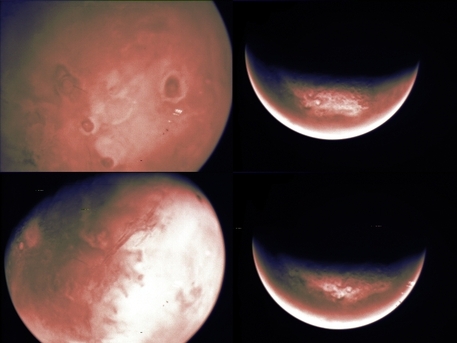Mars-Webcam online again
The latest crescent-shaped pictures from Mars
 © ESA/ Heike Le Roux
|
Picture captured by the VMC camera.
Ormston: On the previous website we counted 283,000 page views between August 2008 and March 2009.
RSL: Why was the camera offline for such a long time?
Ormston: There are two reasons. In the first month of our three month break Mars Express was almost completely in hibernation mode. Mars gets behind the sun, which makes communication through their atmosphere very difficult. There was the danger that we would lose contact to the Mars Express. However the scientific experiments on the space probe depend on a strong communication link. That is why they were paused almost completely for this time.
After we came out on the other side we had a season with great optical conditions for our main instruments like the HRSC camera. They produced a lot of valuable data and used up the whole bandwidth. That is the reason why we stepped into the background with VMC. But now, when Mars is coming closer to Earth, we can send data to Earth faster again. So there is a little extra capacity, where we can squeeze in VMC.
RSL: What do we get to see these days?
Ormston: The latest pictures are very interesting, because of the clouds. On the terminator, the border between light and dark, there are a lot of variations, where the weather moves from the dark into the illuminated side of Mars. Some community members already made interesting animations of these phenomena.
RSL: When will new data come in?
Ormston: April is a relative thin month for VMC, we only have two dates for observations. In May it will get exciting again, since we plan on a lot of VMC observations - three, four or even five per week. There will be numerous updates. The next scheduled observation is on April 9.
However it is quite possible that we get new VMC material earlier. Only half of the data from March 19 has been transmitted to Earth so far, so there are still some pictures on the space probe. I cannot say exactly when they will arrive, but it will probably happen in the next few weeks.
The interview was conducted by Carolin Konermann.
Translation Raphael Steinbach
Go see the website here.
Mars-Webcam online again
The latest crescent-shaped pictures from Mars
 © ESA/ Heike Le Roux
|
Picture captured by the VMC camera.
Ormston: On the previous website we counted 283,000 page views between August 2008 and March 2009.
RSL: Why was the camera offline for such a long time?
Ormston: There are two reasons. In the first month of our three month break Mars Express was almost completely in hibernation mode. Mars gets behind the sun, which makes communication through their atmosphere very difficult. There was the danger that we would lose contact to the Mars Express. However the scientific experiments on the space probe depend on a strong communication link. That is why they were paused almost completely for this time.
After we came out on the other side we had a season with great optical conditions for our main instruments like the HRSC camera. They produced a lot of valuable data and used up the whole bandwidth. That is the reason why we stepped into the background with VMC. But now, when Mars is coming closer to Earth, we can send data to Earth faster again. So there is a little extra capacity, where we can squeeze in VMC.
RSL: What do we get to see these days?
Ormston: The latest pictures are very interesting, because of the clouds. On the terminator, the border between light and dark, there are a lot of variations, where the weather moves from the dark into the illuminated side of Mars. Some community members already made interesting animations of these phenomena.
RSL: When will new data come in?
Ormston: April is a relative thin month for VMC, we only have two dates for observations. In May it will get exciting again, since we plan on a lot of VMC observations - three, four or even five per week. There will be numerous updates. The next scheduled observation is on April 9.
However it is quite possible that we get new VMC material earlier. Only half of the data from March 19 has been transmitted to Earth so far, so there are still some pictures on the space probe. I cannot say exactly when they will arrive, but it will probably happen in the next few weeks.
The interview was conducted by Carolin Konermann.
Translation Raphael Steinbach
Go see the website here.






